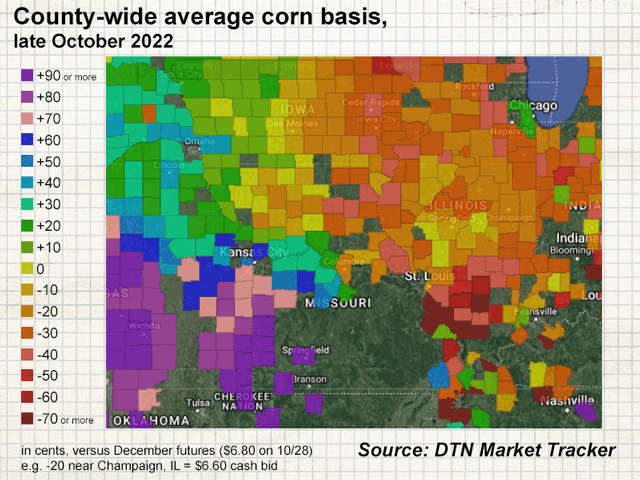Kub's Den
Weak Basis Plagues Egypt, Illinois
During ancient Egypt's Age of the Pyramids, 4,000 years ago, an unrelenting period of arid weather spread across the globe, lowering water levels in the Nile and decimating crop yields along its fertile banks. Famine stalked the land, and the reign of the "Old Kingdom" collapsed. After a time of political struggle, the subsequent "Middle Kingdom" dynasties were able to boast about keeping their populations fed, with a canalized Nile and ambitious construction of grain storage facilities.
Half a world away, when European settlers arrived in present-day southern Illinois, they collectively decided "Egypt" would be a fitting nickname for the region -- fertile land cut through by a mighty river, marked by seasonal floods, capable of producing abundant grain supplies to feed the population centers to the north. (Also, my favorite theory is that the region's pyramid-like mounds built by indigenous Americans had something to do with the nickname, like those at the lost city of Cahokia near St. Louis.)
To this day, the theme lives on in Illinois towns named Cairo, Karnak and Thebes; in monuments and business names; and even in the name of the campus newspaper -- the Daily Egyptian -- at Southern Illinois University in Carbondale. Now, the self-styled "Egyptians" of southern Illinois have a new similarity to help them relate to the ancient Egyptians of 4,000 years ago: a drought-depleted river.
During the last four weeks, barge movements of grain down the Mississippi River (and the Illinois, Ohio and Arkansas rivers) have reached only 86% of the throughput that was possible last year at this time, almost entirely due to the low water conditions and frequent dredging necessary to get barges moving down the Lower Mississippi portion. This isn't a sudden new problem, (https://www.dtnpf.com/…), and DTN has followed the problem with growing dread through the season, but now that we've made it past the gutslot of a high-volume Eastern Corn Belt harvest, i.e. now that the bottlenecked grain has officially run out of space, (https://www.dtnpf.com/…), we may be seeing the purest picture of how local boom-or-bust conditions can shape basis bids and flat cash prices for grain.
P[L1] D[0x0] M[300x250] OOP[F] ADUNIT[] T[]
Commercial grain companies that would ordinarily ship grain by barge are struggling to meet current commitments due to the low availability of barges. And if they can't ship grain, they can't make space to buy new grain. And if they can't buy new grain, they must discourage farmer sellers through exceptionally weak basis and/or they must build in a basis cushion to reflect the suddenly higher freight costs. St. Louis barge rates were up 22% week-over-week to $88.46 per ton on Oct. 25, according to USDA's weekly Grain Transportation Report.
Therefore, basis bids along the river have gone rather extreme -- for example, 90 cents under the December futures contract for corn delivered to a barge-loading facility in Grand Tower, Illinois. Even inland country elevators 85 miles away from the river are plugged up and passing back the weak basis in their farmer bids, which are anywhere from 50 cents under (if they can find alternative feed or ethanol markets to take some grain), to as bad as 94 cents under the December futures contract (if the river is their only feasible market). Two years ago, the late-October corn basis bid at that example countryside elevator was only 18 cents under the futures price, to give you an idea of what a more "normal" gutslot of harvest basis bid might look like in that part of the country.
That means farmers in "Egypt," Illinois, may be getting less than $6.00 per bushel of corn they deliver to an elevator, but meanwhile, 360 miles straight west across the state of Missouri, basis bids for corn in eastern Kansas are generally at least 70 cents OVER the futures price, making a flat cash bid of at least $7.60 per bushel at the end of October. On the southwestern edge of that drought-ravaged state, bids are $1.50 over the futures price (i.e., $8.43 per bushel on Monday).
Just looking from one edge of Missouri to the other, the corn basis market is showing a historically bizarre spread that's at least $1.70 wide. That's $1,615 of arbitrage value for a truck hauling 950 bushels of corn, which calculates out to $4.59 per mile, for instance, for a 352-mile haul from the edge of Illinois to the edge of Kansas. Even with rising diesel costs (and rising labor costs and everything else), you'd think somebody could get some eastern corn moving by truck into the vacuum of Kansas and relieve its desperate scarcity of feed grains.
Or, I guess, if you wait long enough everything might work out in the end. The ancient Egyptians' solution to the Nile's uncertainties was building large grain storage facilities to keep the grain in condition until shipping conditions improved. Storage (both off- and on-farm) may be the solution today too. Forward St. Louis barge freight rates for November ($58.61 per ton) and January ($33.99 per ton) show that the market is anticipating fall rains that will hopefully normalize operations on the Lower Mississippi and bring glory back to "Egypt."
**
Comments above are for educational purposes only and are not meant as specific trade recommendations. The buying and selling of grain or grain futures or options involve substantial risk and are not suitable for everyone.
Elaine Kub, CFA is the author of "Mastering the Grain Markets: How Profits Are Really Made" and can be reached at masteringthegrainmarkets@gmail.com or on Twitter @elainekub.
(c) Copyright 2022 DTN, LLC. All rights reserved.




